The OCZ Trion 150 SSD Review
by Billy Tallis on April 1, 2016 8:00 AM ESTATTO
ATTO's Disk Benchmark is a quick and easy freeware tool to measure drive performance across various transfer sizes.
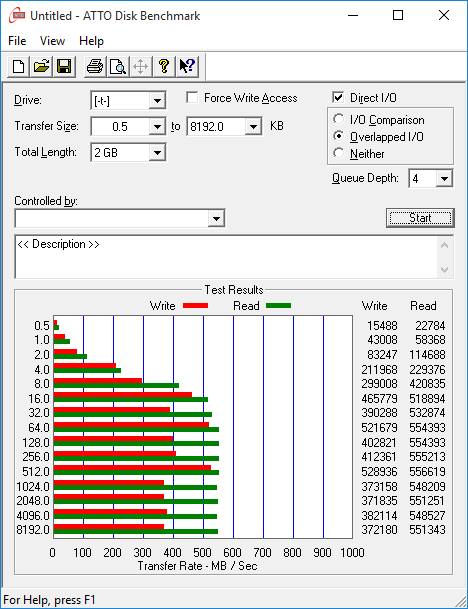 |
|||||||||
The 240GB Trion 150's write speeds are a bit uneven, but the larger capacities are perfectly normal with write speeds that are only slightly behind read speeds.
AS-SSD
AS-SSD is another quick and free benchmark tool. It uses incompressible data for all of its tests, making it an easy way to keep an eye on which drives are relying on transparent data compression. The short duration of the test makes it a decent indicator of peak drive performance.
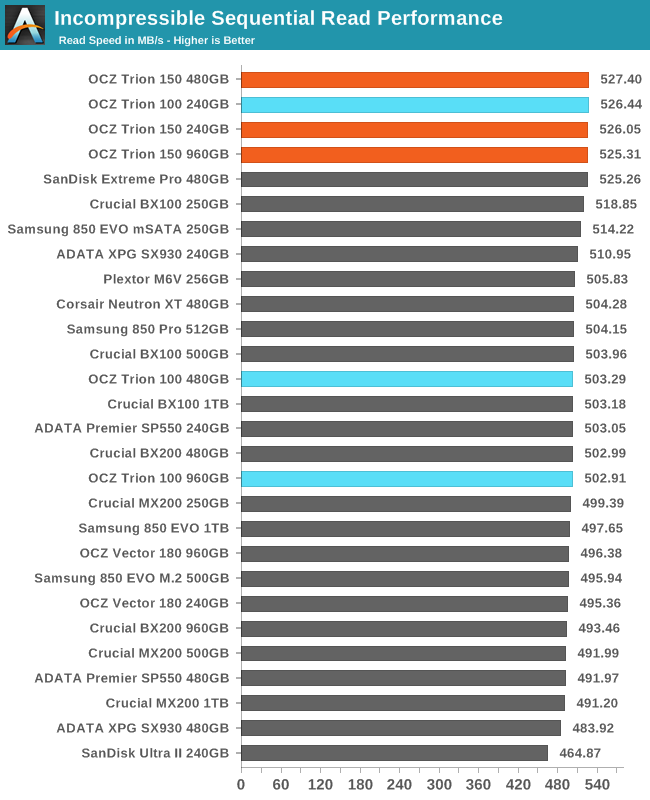
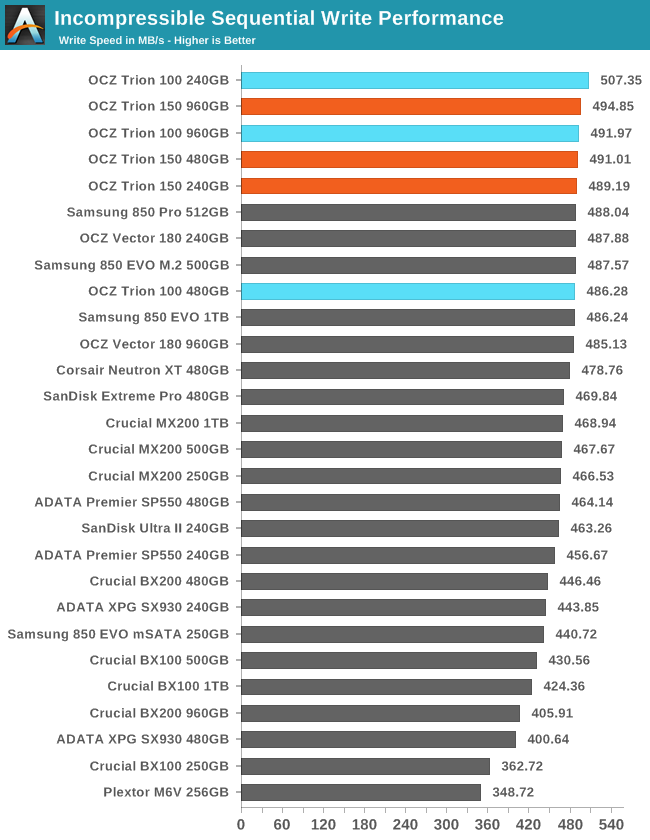
The Trion 150 manages to mostly top the (SATA) charts for peak read and write speeds, but the distinction is meaningless given how close the competition is.
Idle Power Consumption
Since the ATSB tests based on real-world usage cut idle times short to 25ms, their power consumption scores paint an inaccurate picture of the relative suitability of drives for mobile use. During real-world client use, a solid state drive will spend far more time idle than actively processing commands. Our testbed doesn't support the deepest DevSlp power saving mode that SATA drives can implement, but we can measure the power usage in the intermediate slumber state where both the host and device ends of the SATA link enter a low-power state and the drive is free to engage its internal power savings measures.
We also report the drive's idle power consumption while the SATA link is active and not in any power saving state. Drives are required to be able to wake from the slumber state in under 10 milliseconds, but that still leaves plenty of room for them to add latency to a burst of I/O. Because of this, many desktops default to either not using SATA Aggressive Link Power Management (ALPM) at all or to only enable it partially without making use of the device-initiated power management (DIPM) capability. Additionally, SATA Hot-Swap is incompatible with the use of DIPM, so our SSD testbed usually has DIPM turned off during performance testing.
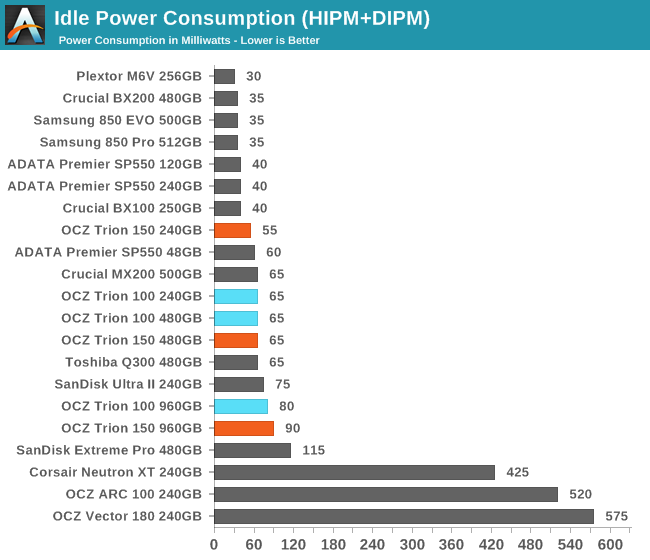
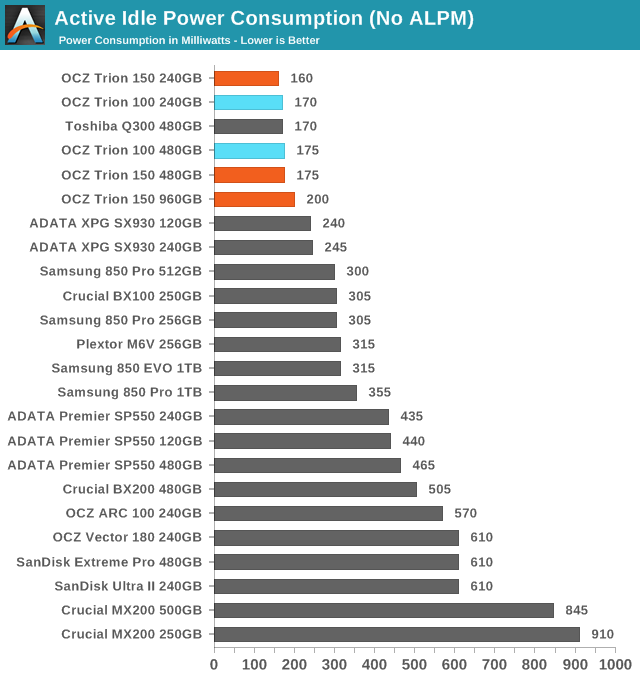
With and without DIPM, the Trion 150 has similar idle power consumption to its predecessors based on the TC58 controller. It's the best at saving power when ALPM is unavailable, and its device-initiated power management works properly.










79 Comments
View All Comments
Hulk - Saturday, April 2, 2016 - link
So I might be doing this calc wrong but I'm seeing the endurance as 250 drive writes? Probably fine for most people and definitely for a media storage drive. Prices are getting low enough for that.stephenbrooks - Saturday, April 2, 2016 - link
I'd prefer it if they just stated endurance in drive writes rather than as 9,876PB or something. I end up doing the mental arithmetic to divide it down to drive writes every time I see that in the table anyway.nikon133 - Monday, April 4, 2016 - link
I got one 480GB Trion 100 for my old Elitebook upgrade.I knew what I'm buying and I am very pleased with it. Here in NZ, I paid 480GB Trion around NZ$30 more than what I would pay for 250GB Samsug 850 EVO (non-pro): they were NZ$150 and 180. I wanted more capacity but didn't want to overspend for machine I rarely use these days.
While it is slow for SSD, it still is revelation in everyday use, compared to HDD. Windows 10 boot time is quick anyway, and SSD takes away all that after-login sluggishness while system is still loading background processes/drivers/utils/...
Like I said, champ it is not, but huge improvement over HDD it is.
SeanJ76 - Tuesday, April 5, 2016 - link
Your pretty damn poor if you can't afford a Intel SSD. Intel will always make the best SSD on the market, they've been in the business the longest!xrror - Wednesday, April 6, 2016 - link
I'm sure glad that brand loyalty makes you a consumer retard. Never compare, never revisit your set opinions. Way to be a true patriot. =(nikon133 - Monday, April 11, 2016 - link
Well said.slowdemon21 - Friday, April 29, 2016 - link
I'm using in PS4 with great resultsprefereduser - Friday, June 3, 2016 - link
OCZ Trion 150 SSD 120GB benchmarks Athon II x4 845 4 GB ramWindows 10 clean install on a Sata III port .
Seq R/W is 130.30 MB/s and 107.29 MB/s respectively
4K = 15.37 MB/s read and 20.71 MB/s
4K -64 Thrd read = 25.55 MB/s write = 52.01 MB/s
Acc. time = 0.274ms read and 0.141ms write
I was looking for more than that (maybe twice or more on seq r/w at least ) but not as much as the i7 test box here even though this is low end part .
OTOH it feels *a lot faster the the not old 1TB 5700 rpm metal hdd ever did and def rag is disabled in windows 10 . .
What you think?
hp79 - Wednesday, September 21, 2016 - link
Is this different from OCZ TR150 (current model)? Looking at the specification of the 480GB on their website (https://ocz.com/us/ssd/tr150-ssd#specs), they are quite different from the TRION 150 480GB in this table. The 4K Write shows up to 83K IOPS instead of the 54K IOPS shown in the table. Others numbers are close though.I have a Trion 150 480GB which I paid $60 at Frys during an awesome sale (probably pricing error). Working very well for my laptop working as a HTPC/home file server.